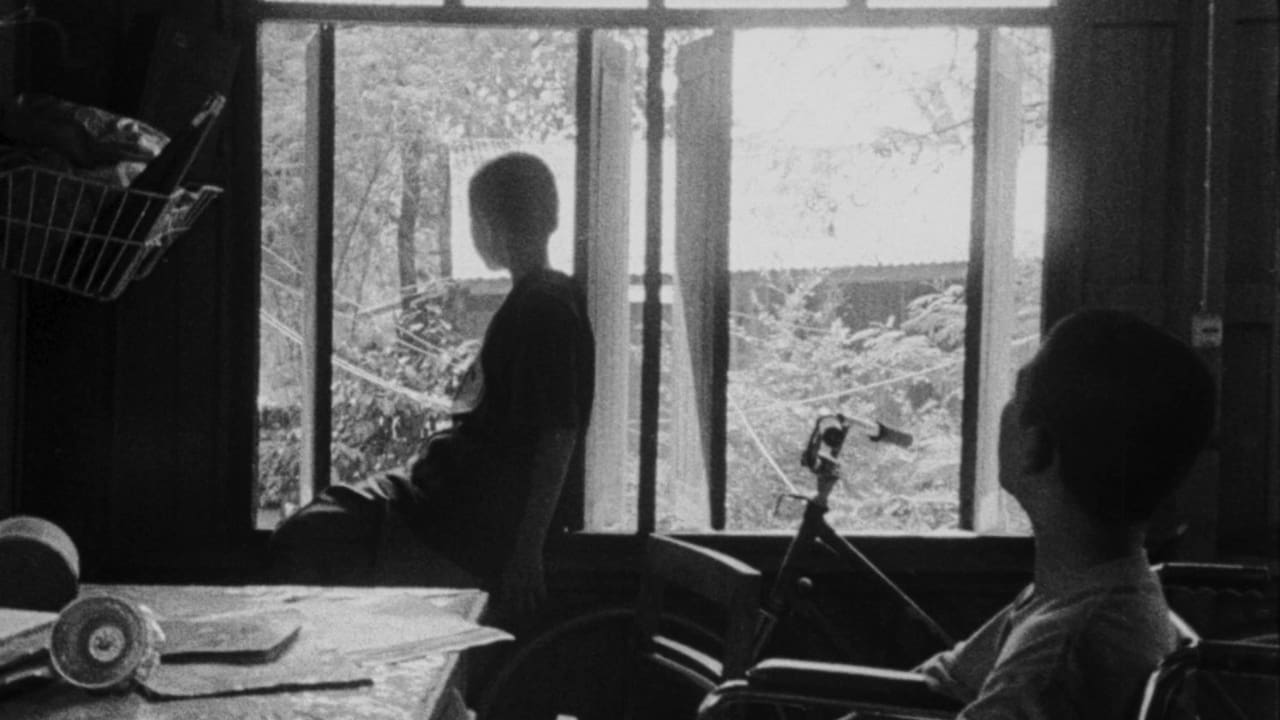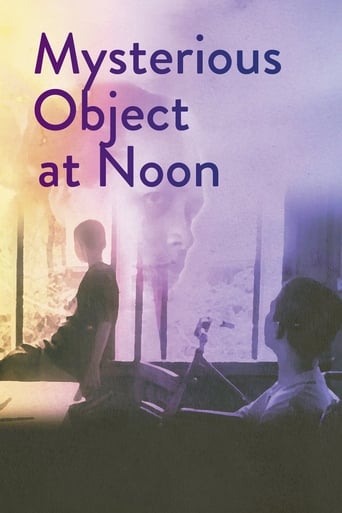Phonearl
Good start, but then it gets ruined
Pacionsbo
Absolutely Fantastic
Salubfoto
It's an amazing and heartbreaking story.
Roman Sampson
One of the most extraordinary films you will see this year. Take that as you want.
chaos-rampant
An interesting film, more for the idea behind it and moments captured than the overall execution.A filmmaker rolls around town in search of a story, making the film we see. It begins with long footage of driving around Bangkok, then we segue to the story proper with a woman being interviewed, asked about a story.The story is made-up, the point is not the story of course, but dismantling the conventional telling. Different people are interviewed who bend the story to their fancy, adding stuff. We are not entirely sure who among them are actors coached on what to say, who are passers-by blurting out what comes in their heads. We can tell that some of it was obviously blocked to be filmed, some covertly staged as real and some stolen from glances but the whole is pretty seamless.This is an opportunity to film all sorts of activities and splice it together to see what kind of sense comes out; among them an amateur theatric production of the story, a simulated TV interview filmed off the TV, (faux?) newsreel footage, real scenes of boxing, a singing contest and sex show, a scene from the film but the camera keeps rolling through the break. When the crippled boy is assigned a random background by one of the interviewees, in the following scene his teacher acquires the same background of war and family loss.In the West, we have similar films of stories about stories in Saragossa Manuscript and such, where usually the point is structure, hidden meaning and the divination of self.In the East, specifically Thailand, they have their own traditions of light storytelling and meta-narrative sorting of concepts, both defined by cultural proximity to India. Among the three 'holy' texts of their native Buddhism is a body of work called Abhidharma, teachings about the teachings. Composed after the Buddha's time, commentaries upon commentaries form a complex, layered web of cataloguing various ontological attributes of reality, phenomena and self. Boring if you ever try to read it.On a historical note, there is evidence that abhidharmic influence in the north of India in turn rippled West through Persia to influence gnostic thought, and East through the Silk Road as both reaction to its scholasticism and elaboration of it contributed to early Chinese Buddhism. In both cases, the distinction is made between mere intellectual reasoning in the abhidharmic vein, and expansive meditative wisdom that looks directly at things. (respectively, gnosis and prajna)Anyway, the film has no direct link to all that except as pointing to the mesh of meta-narrative. And it's cool to note that springing from a Buddhist background, in this film of stories about stories the stories are transient, illusory confabulations, there's no intrinsic meaning or symbolism to them, there's no structure beyond co-dependent arising of narrator and image, and the narrator is neither a single self nor on some journey to enlightenment. Nice, if you don't burden yourself with futilely trying to organize the tangle, just directly look at the wondrous nothingness.The last story is made-up by schoolchildren, collapsing in a fantastical, meaningless heap of witch tigers and magical swords, illusory child's play. The closing shots are of children kicking a ball, the rush of actual life outside the stories which is the most mysterious object of all.
Howard Schumann
A camera attached to a moving car takes us down a busy city street in Thailand. Abruptly, the car turns into a narrow alley where we see brush grass and run down shacks. As the camera enters one of the houses, a heavy-set woman speaks of the trauma involved in her being sold into prostitution by her father. When she is finished, an off-camera voice asks her to tell another story, real or fiction. It is then that we begin to sense that cinematically we are in unchartered territory. Internationally acclaimed Thai director Apichatpong Weerasethakul's first feature Mysterious Object at Noon is an offbeat mixture of reality and fiction in which there is no screenplay or linear narrative, only a story created and added to by each participant in the mode of the French game "exquisite corpse".The story the woman first tells is that of a teacher named Dogfahr whose young pupil is a cripple confined to a wheelchair. The tale is then dramatized on screen by non actors alternating with the talking storyteller. As the camera moves north and south of Bangkok into the Thai countryside, a cross section of Thai's continue the story by adding a few lines. These include two deaf girls using sign language, a song and dance troupe, and children in a rural Thai school. With each addition, the tale becomes vastly different and increasingly fantastic. The mysterious object in the title falls from the teacher who has collapsed and turns into an extraterrestrial boy with strange powers, a duplicate teacher, and finally a "witch tiger" and a magic sword.Some sequences stand by themselves and are without any relation to the continuing storyline. The teacher brings her father to the doctor for a hearing test and complains of a strange line around her neck which the doctor dismisses as an allergy or the effect of wearing her necklace. Parents talk of a boy who escaped death in a plane crash because he was protected by amulets, and a scene shows women bargaining at a fish market. An experimental film with a small budget shot in 16-millimeter black and white, Mysterious Object at Noon glows with warmth and playfulness. As it progresses, it also slows down and becomes more of a meditation on Thai culture, creating a mood of tranquility and peace. Like Seinfeld, it is ostensibly "about nothing", but turns out to be about everything.
ThurstonHunger
This approaches art, and does so from an oblique angle and in an exotic locale. That being said for me, it never achieves that art., Despite the loose effort to stitch a thread of a story through this, and some curious disjointed elements, the whole does not hold.See this film if you are willing to bring a lot to the party. (And kudos to you, davidals@msn.com) Or play it in your rental store, or during a party with the sound off, and it will probably snare more fish than it does standing alone with you and your remote. I'm all for experimental film, this could have been whittled down to a 7 minute beauty for the Ann Arbor Film Fest; at 83 min, it came across as a chore, a corpse less than exquisite. And while I'm coming across as the anti-hipster, why black (or almost a dusty brown) and white for this film? Color I think would have made this more florid and captivating, although perhaps more common-place and thus undermined the art?Wait till your film professor assigns this one to you.3/10
David
*Possible Spoilers*Director Apichatpong Weerasethakul crafted one of the more unique debut films to appear in quite a while with MYSTERIOUS OBJECT AT NOON, which generated a significant buzz on the global festival circuit and seems to mark the beginning of a very promising film career.Weerasethakul's dreamy not-quite-drama, not-quite-documentary opens with a view down a freeway, taking in the skyline of Bangkok (in opening scenes that evoke the infamous 'freeway' scene in Andrei Tarkovsky's SOLARIS), before gliding down a highway exit into progressively smaller side streets, eventually ending up in a neighborhood and finding the first of his many subject/character/author/collaborators (nearly everyone appearing in the film is simultaneously all four). A woman relates a grim, true story and pauses before spinning off into another story, this one invented. Weerasethakul starts with the shard of a story invented here, and - using the Surrealist 'Exquisite Corpse' game/technique - asks everyone else he encounters to add to it - then editing the results (after three years of compiling footage) into MYSTERIOUS OBJECT. With a story that is invented - as both an experiment in film, and a piece of collectively generated contemporary folklore - almost literally as you watch (excepting Weetasethakul's editing - the finished product was stitched together from 3+ hours of footage), this film shatters all kinds of boundaries - between experimental art and folklore, between fiction and documentary, between numerous stylistic genres, and between author/artist/creative mind and spectator/viewer/consumer. The individuals appearing in the film are non-actors; the story, which starts as a folkloric tale about a handicapped boy and his teacher, veers off into something resembling mythologic sci-fi. Throughout MYSTERIOUS OBJECT, bits of documentary footage suddenly give way to seamless reenactments of the story (as it is being told), often interspersed with 'found' bits of news footage or soap operas (which all seem to end up commenting on the narrative as it evolves); in one scene late in the film, the director and crew step into the film, revealing (in their workmanlike actions) some of the process behind it all, and incorporating that into the ever-evolving story as well. The cinematography of MYSTERIOUS OBJECT reminded me somewhat of BREATHLESS - the stories are dissimilar, but the grainy, atmospheric black-and-white look is pleasantly similar, and they share an energetic willingness to tinker with notions of what films can or can't be. And - without resorting to exoticism, cuteness or pandering to any outside cultural expectations, a variable view of Thailand is offered, moving with ease across the varied religious, cultural and economic divides in Thai society. The consistently rich and affectionate glimpses of rural and urban landscapes and the diversity of the participants makes for compelling viewing - experimentalist or not, Weerasethakul gives everyone the opportunity to reveal his or her own personality during their shining moment on screen, creating a kaleidoscope of humor, quirkiness and/or mundane realism. The end result is a surprising mix of the avant-garde and the affectionate, infused with both a great love of intrepid experimentalism and of Thai life and society at its' most everyday and average, and offering a great meditation on creativity as well in this remarkably crafted and most unusual film.

